A vertical garden is a creative and space-saving way to grow plants when you’re short on yard space or want to bring greenery indoors. By growing plants upwards instead of outwards, you can transform a dull wall, balcony, or corner into a lush, green oasis. Whether you’re aiming for a decorative wall of flowers, a herb garden in your kitchen, or a leafy privacy screen, vertical gardening is both practical and beautiful.
In this guide, we’ll walk you through everything you need to know — from planning and selecting plants to building and maintaining your own vertical garden at home.
1. Why Build a Vertical Garden?
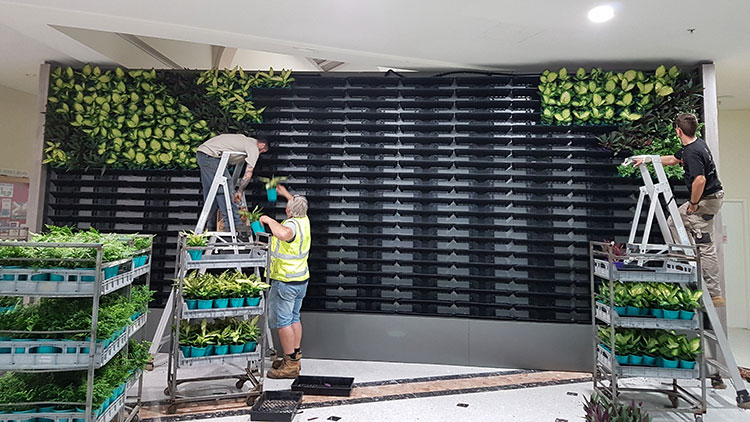
Before diving into the steps, it’s important to understand why vertical gardening is gaining popularity:
- Space Efficiency – Ideal for apartments, balconies, or small backyards.
- Aesthetic Appeal – Turns plain walls into eye-catching green features.
- Better Air Quality – Plants help purify the air and reduce pollutants.
- Ease of Maintenance – Plants are at eye level, so watering, pruning, and harvesting are easier.
- Versatility – Can be used for flowers, herbs, vegetables, or even succulents.
A vertical garden is not just a gardening choice — it’s a lifestyle upgrade.
2. Choosing the Right Location
The success of your vertical garden starts with location. Consider the following factors:
Sunlight
Most plants need at least 4–6 hours of sunlight daily. If your wall faces north or east, it may get indirect light, making it better suited for shade-loving plants like ferns or pothos. South or west-facing walls are perfect for sun-loving plants like herbs, tomatoes, or petunias.
Accessibility
Choose a spot where you can easily water, prune, and check plants for pests.
Weight Support
Vertical gardens can get heavy when filled with soil and plants. Ensure your wall, fence, or support frame is strong enough to handle the load.
3. Types of Vertical Gardens
You have several options depending on your style, budget, and skill level:
A. Wall Planters
Individual pots or planter boxes mounted on walls. Great for herbs and flowers.
B. Pocket Planters
Fabric or felt pockets that hold soil and plants. Ideal for lightweight plants and herbs.
C. Trellises & Climbing Supports
Perfect for plants like cucumbers, beans, or flowering vines.
D. Modular Panels
Ready-made panels with built-in irrigation systems for professional-looking vertical gardens.
E. DIY Upcycled Options
Use wooden pallets, shoe organizers, or old bookshelves as plant holders.
4. Materials You’ll Need
Before you start building, gather the right tools and supplies:
- Frame or Support – Wooden pallets, metal mesh, or wall brackets.
- Pots or Planter Boxes – Plastic, ceramic, or recycled containers.
- Potting Mix – Lightweight, well-draining soil.
- Plants – Choose based on light and climate conditions.
- Irrigation System or Watering Can – Drip irrigation is ideal for large gardens.
- Fertilizer – Organic compost or slow-release plant food.
- Mounting Tools – Screws, nails, brackets, and a drill.
5. Choosing the Right Plants
The plants you choose will depend on your location and the type of vertical garden.
For Sunny Spots:
- Herbs: Basil, rosemary, oregano, thyme
- Vegetables: Cherry tomatoes, peppers, lettuce
- Flowers: Petunias, marigolds, geraniums
For Shady Spots:
- Ferns
- Pothos
- Peace lily
- Mint
Low-Maintenance Options:
- Succulents
- Spider plants
- ZZ plants
6. Step-by-Step Guide to Building Your Vertical Garden
Here’s a simple yet effective process to follow:
Step 1: Plan Your Design
Sketch your garden layout — how many plants, type of support, and placement.
Step 2: Prepare the Frame
If using wood, treat it with waterproof sealant to prevent rot. Metal frames should be rust-proof.
Step 3: Install the Support
Securely mount the frame, pallet, or trellis to your chosen location. Ensure it can handle the weight.
Step 4: Prepare Containers
Drill drainage holes in pots or planters to prevent waterlogging.
Step 5: Add Potting Mix
Use a lightweight, nutrient-rich, well-draining soil mix. You can mix compost, peat moss, and perlite for best results.
Step 6: Plant Carefully
Place taller plants at the bottom, trailing plants at the edges, and smaller plants in upper positions for easy watering.
Step 7: Water & Fertilize
Water regularly but avoid overwatering. For vertical gardens, drip irrigation or self-watering systems work best. Feed plants every 3–4 weeks with organic fertilizer.
7. Maintenance Tips for a Healthy Vertical Garden
A vertical garden may require less ground space, but it still needs regular care:
- Water Wisely – Check soil moisture before watering. Overwatering can cause root rot.
- Prune Regularly – Remove dead leaves and encourage new growth.
- Watch for Pests – Aphids, mealybugs, and spider mites can hide in dense foliage.
- Replace Old Plants – If a plant is struggling, replace it to keep the garden lush.
- Fertilize Consistently – Use balanced plant food to replenish nutrients.
8. Common Problems & Solutions
| Problem | Cause | Solution |
|---|---|---|
| Plants wilting quickly | Underwatering or poor soil mix | Improve watering schedule, use better soil |
| Yellowing leaves | Overwatering or nutrient deficiency | Reduce watering, add fertilizer |
| Plants not growing well | Lack of sunlight | Move garden to a sunnier location |
| Mold or fungus on soil | Excess moisture | Improve drainage and airflow |
9. Creative Ideas to Make It Stand Out
- Mix colors & textures – Combine flowers with foliage plants for visual appeal.
- Add LED Grow Lights – Perfect for indoor gardens with low light.
- Use Recycled Materials – Pallets, cans, or old wooden crates for an eco-friendly touch.
- Include Aromatic Plants – Basil, lavender, and mint for fragrance.
- Incorporate Edible Plants – Herbs and vegetables for fresh kitchen ingredients.
10. Benefits Beyond Beauty
A vertical garden isn’t just about looks — it can:
- Reduce heat and noise in your home.
- Provide fresh herbs and vegetables year-round.
- Improve mood and mental well-being.
- Increase property value.
Conclusion
Building a vertical garden at home is a rewarding project that brings nature into your living space while making the most of limited room. With the right location, design, and plant choices, you can enjoy a lush wall of greenery that’s easy to maintain and incredibly satisfying to look at.
Start small, experiment with plant combinations, and soon you’ll have your own thriving vertical oasis — a testament to the beauty of gardening creativity.
A vertical garden is a creative and space-saving way to grow plants when you’re short on yard space or want to bring greenery indoors. By growing plants upwards instead of outwards, you can transform a dull wall, balcony, or corner into a lush, green oasis. Whether you’re aiming for a decorative wall of flowers, a herb garden in your kitchen, or a leafy privacy screen, vertical gardening is both practical and beautiful.
In this guide, we’ll walk you through everything you need to know — from planning and selecting plants to building and maintaining your own vertical garden at home.
1. Why Build a Vertical Garden?
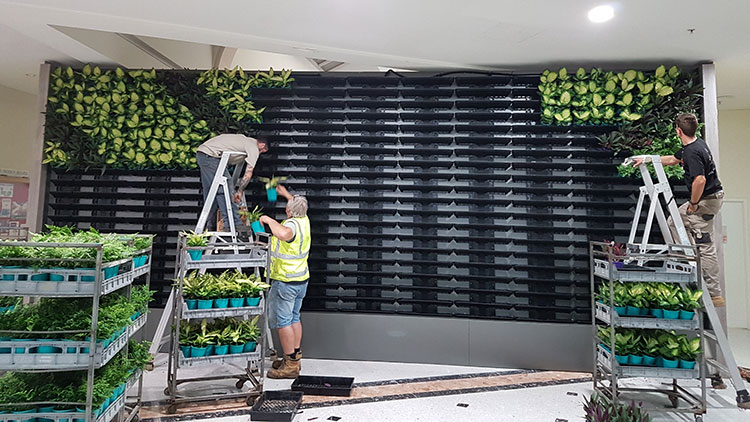
Before diving into the steps, it’s important to understand why vertical gardening is gaining popularity:
- Space Efficiency – Ideal for apartments, balconies, or small backyards.
- Aesthetic Appeal – Turns plain walls into eye-catching green features.
- Better Air Quality – Plants help purify the air and reduce pollutants.
- Ease of Maintenance – Plants are at eye level, so watering, pruning, and harvesting are easier.
- Versatility – Can be used for flowers, herbs, vegetables, or even succulents.
A vertical garden is not just a gardening choice — it’s a lifestyle upgrade.
2. Choosing the Right Location
The success of your vertical garden starts with location. Consider the following factors:
Sunlight
Most plants need at least 4–6 hours of sunlight daily. If your wall faces north or east, it may get indirect light, making it better suited for shade-loving plants like ferns or pothos. South or west-facing walls are perfect for sun-loving plants like herbs, tomatoes, or petunias.
Accessibility
Choose a spot where you can easily water, prune, and check plants for pests.
Weight Support
Vertical gardens can get heavy when filled with soil and plants. Ensure your wall, fence, or support frame is strong enough to handle the load.
3. Types of Vertical Gardens
You have several options depending on your style, budget, and skill level:
A. Wall Planters
Individual pots or planter boxes mounted on walls. Great for herbs and flowers.
B. Pocket Planters
Fabric or felt pockets that hold soil and plants. Ideal for lightweight plants and herbs.
C. Trellises & Climbing Supports
Perfect for plants like cucumbers, beans, or flowering vines.
D. Modular Panels
Ready-made panels with built-in irrigation systems for professional-looking vertical gardens.
E. DIY Upcycled Options
Use wooden pallets, shoe organizers, or old bookshelves as plant holders.
4. Materials You’ll Need
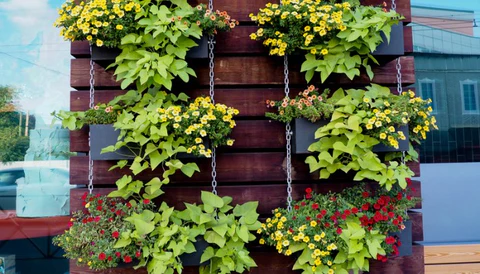
Before you start building, gather the right tools and supplies:
- Frame or Support – Wooden pallets, metal mesh, or wall brackets.
- Pots or Planter Boxes – Plastic, ceramic, or recycled containers.
- Potting Mix – Lightweight, well-draining soil.
- Plants – Choose based on light and climate conditions.
- Irrigation System or Watering Can – Drip irrigation is ideal for large gardens.
- Fertilizer – Organic compost or slow-release plant food.
- Mounting Tools – Screws, nails, brackets, and a drill.
5. Choosing the Right Plants
The plants you choose will depend on your location and the type of vertical garden.
For Sunny Spots:
- Herbs: Basil, rosemary, oregano, thyme
- Vegetables: Cherry tomatoes, peppers, lettuce
- Flowers: Petunias, marigolds, geraniums
For Shady Spots:
- Ferns
- Pothos
- Peace lily
- Mint
Low-Maintenance Options:
- Succulents
- Spider plants
- ZZ plants
6. Step-by-Step Guide to Building Your Vertical Garden
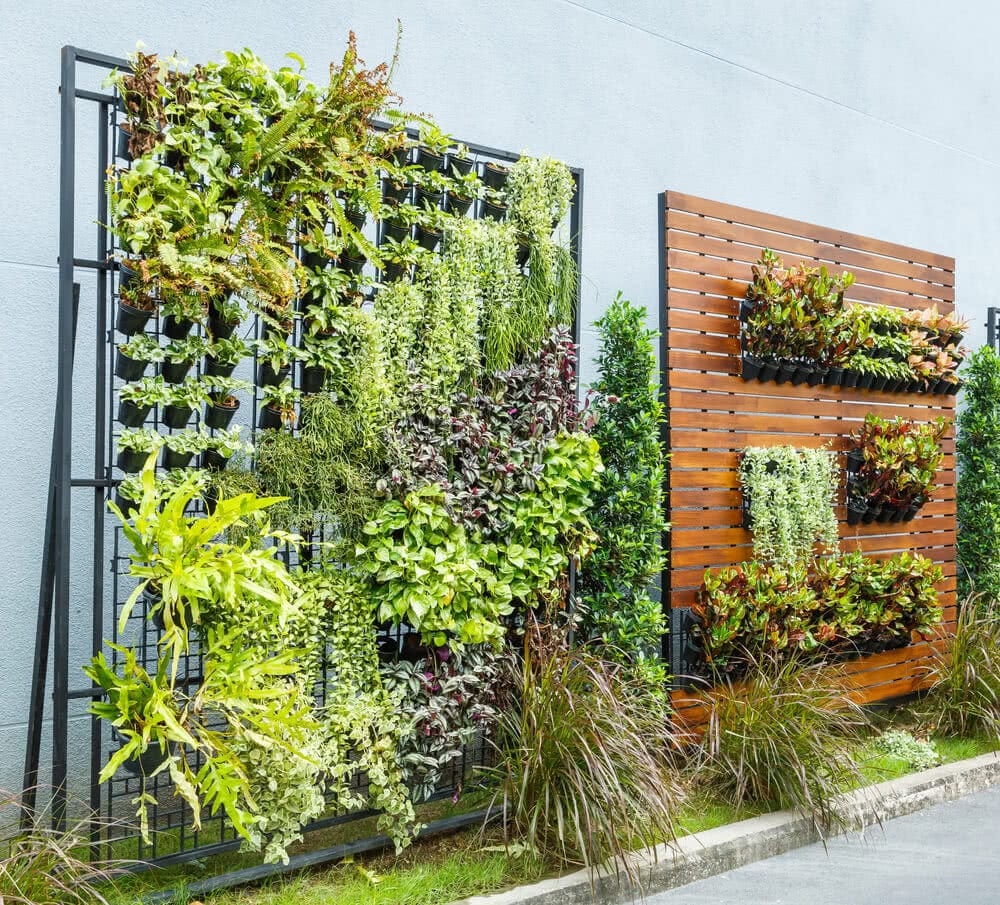
Here’s a simple yet effective process to follow:
Step 1: Plan Your Design
Sketch your garden layout — how many plants, type of support, and placement.
Step 2: Prepare the Frame
If using wood, treat it with waterproof sealant to prevent rot. Metal frames should be rust-proof.
Step 3: Install the Support
Securely mount the frame, pallet, or trellis to your chosen location. Ensure it can handle the weight.
Step 4: Prepare Containers
Drill drainage holes in pots or planters to prevent waterlogging.
Step 5: Add Potting Mix
Use a lightweight, nutrient-rich, well-draining soil mix. You can mix compost, peat moss, and perlite for best results.
Step 6: Plant Carefully
Place taller plants at the bottom, trailing plants at the edges, and smaller plants in upper positions for easy watering.
Step 7: Water & Fertilize
Water regularly but avoid overwatering. For vertical gardens, drip irrigation or self-watering systems work best. Feed plants every 3–4 weeks with organic fertilizer.
7. Maintenance Tips for a Healthy Vertical Garden

A vertical garden may require less ground space, but it still needs regular care:
- Water Wisely – Check soil moisture before watering. Overwatering can cause root rot.
- Prune Regularly – Remove dead leaves and encourage new growth.
- Watch for Pests – Aphids, mealybugs, and spider mites can hide in dense foliage.
- Replace Old Plants – If a plant is struggling, replace it to keep the garden lush.
- Fertilize Consistently – Use balanced plant food to replenish nutrients.
8. Common Problems & Solutions
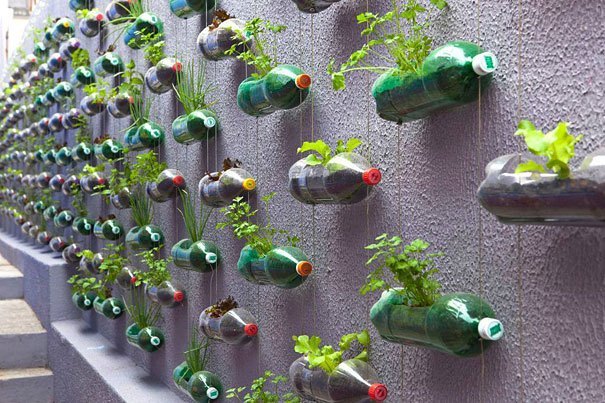
| Problem | Cause | Solution |
|---|---|---|
| Plants wilting quickly | Underwatering or poor soil mix | Improve watering schedule, use better soil |
| Yellowing leaves | Overwatering or nutrient deficiency | Reduce watering, add fertilizer |
| Plants not growing well | Lack of sunlight | Move garden to a sunnier location |
| Mold or fungus on soil | Excess moisture | Improve drainage and airflow |
9. Creative Ideas to Make It Stand Out
- Mix colors & textures – Combine flowers with foliage plants for visual appeal.
- Add LED Grow Lights – Perfect for indoor gardens with low light.
- Use Recycled Materials – Pallets, cans, or old wooden crates for an eco-friendly touch.
- Include Aromatic Plants – Basil, lavender, and mint for fragrance.
- Incorporate Edible Plants – Herbs and vegetables for fresh kitchen ingredients.
10. Benefits Beyond Beauty
A vertical garden isn’t just about looks — it can:
- Reduce heat and noise in your home.
- Provide fresh herbs and vegetables year-round.
- Improve mood and mental well-being.
- Increase property value.
Conclusion
Building a vertical garden at home is a rewarding project that brings nature into your living space while making the most of limited room. With the right location, design, and plant choices, you can enjoy a lush wall of greenery that’s easy to maintain and incredibly satisfying to look at.
Start small, experiment with plant combinations, and soon you’ll have your own thriving vertical oasis — a testament to the beauty of gardening creativity.


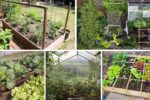

Leave A Comment